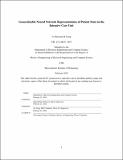| dc.contributor.advisor | John Guttag and Jen Gong. | en_US |
| dc.contributor.author | Gong, Maryann M. | en_US |
| dc.contributor.other | Massachusetts Institute of Technology. Department of Electrical Engineering and Computer Science. | en_US |
| dc.date.accessioned | 2019-11-12T18:13:01Z | |
| dc.date.available | 2019-11-12T18:13:01Z | |
| dc.date.issued | 2018 | en_US |
| dc.identifier.uri | https://hdl.handle.net/1721.1/122909 | |
| dc.description | This electronic version was submitted by the student author. The certified thesis is available in the Institute Archives and Special Collections. | en_US |
| dc.description | Thesis: M. Eng., Massachusetts Institute of Technology, Department of Electrical Engineering and Computer Science, 2018 | en_US |
| dc.description | Cataloged from student-submitted PDF version of thesis. "February 2018." | en_US |
| dc.description | Includes bibliographical references (pages 28-29). | en_US |
| dc.description.abstract | Understanding changes in physiology in patients in the Intensive Care Unit (ICU) is important in determining care decisions. Machine learning algorithms have been used to model patient physiology to predict patient outcomes and administration of interventions. These predictions can be made directly on the raw patient data extracted from electronic health records. However, this data can be high dimensional with extraneous information. Neural networks, and in particular, autoencoders and sequence-to-sequence models, can be used to extract the important attributes of this time-series data without manual feature selection. In this work, we explore how learned encoded representations of physiological time-series and events time-series can be used to effectively predict outcomes on a variety of tasks. We compare the representations extracted from sequence-to-sequence models with representations extracted from autoencoders. We evaluate these representations on the task of predicting patient mortality and first onset of ventilator and vasopressor interventions. Our best representations achieve AUCs of 0.83, 0.91, and 0.91 on the tasks of mortality prediction, vasopressor first onset prediction, and ventilator first onset prediction, which is comparable to the performances using the raw features. | en_US |
| dc.description.statementofresponsibility | by Maryann M. Gong. | en_US |
| dc.format.extent | 29 pages | en_US |
| dc.language.iso | eng | en_US |
| dc.publisher | Massachusetts Institute of Technology | en_US |
| dc.rights | MIT theses are protected by copyright. They may be viewed, downloaded, or printed from this source but further reproduction or distribution in any format is prohibited without written permission. | en_US |
| dc.rights.uri | http://dspace.mit.edu/handle/1721.1/7582 | en_US |
| dc.subject | Electrical Engineering and Computer Science. | en_US |
| dc.title | Generalizable neural network representations of patient state in the intensive care unit | en_US |
| dc.type | Thesis | en_US |
| dc.description.degree | M. Eng. | en_US |
| dc.contributor.department | Massachusetts Institute of Technology. Department of Electrical Engineering and Computer Science | en_US |
| dc.identifier.oclc | 1126543154 | en_US |
| dc.description.collection | M.Eng. Massachusetts Institute of Technology, Department of Electrical Engineering and Computer Science | en_US |
| dspace.imported | 2019-11-12T18:13:00Z | en_US |
| mit.thesis.degree | Master | en_US |
| mit.thesis.department | EECS | en_US |
